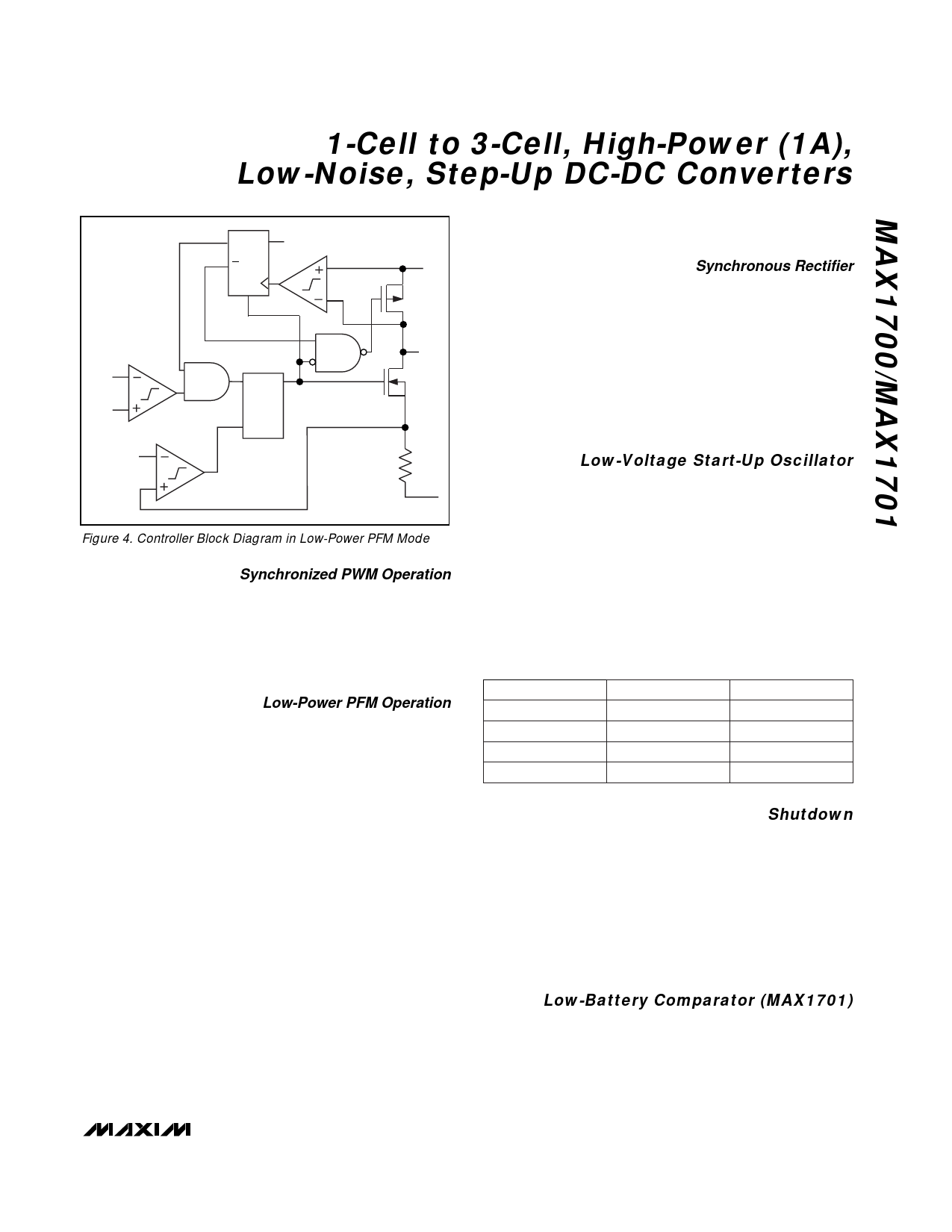MAX1700EEE-T 查看數據表(PDF) - Maxim Integrated
零件编号
产品描述 (功能)
生产厂家
MAX1700EEE-T Datasheet PDF : 16 Pages
| |||

1-Cell to 3-Cell, High-Power (1A),
Low-Noise, Step-Up DC-DC Converters
ERROR
COMPARATOR
FB
REF
400mA
CURRENT
LIMIT
QD
Q
R
LOGIC HIGH
SQ
R
POUT
P
LX
N
PGND
Figure 4. Controller Block Diagram in Low-Power PFM Mode
Synchronized PWM Operation
By applying an external clock to CLK/SEL, the
MAX1700/MAX1701 can also be synchronized in PWM
mode to a frequency between 200kHz and 400kHz.
This allows the user to set the harmonics to avoid IF
bands in wireless applications. The synchronous rectifi-
er is also active during synchronized PWM operation.
Low-Power PFM Operation
Pulling CLK/SEL low places the MAX1700/MAX1701 in
a low-power mode. During low-power mode, PFM oper-
ation regulates the output voltage by transferring a
fixed amount of energy during each cycle and then
modulating the switching frequency to control the
power delivered to the output. The devices switch only
as needed to service the load, resulting in the highest
possible efficiency at light loads. Output current capa-
bility in PFM mode is 100mA. The output voltage is typi-
cally 1% higher than the output voltage in PWM mode.
During PFM operation, the error comparator detects the
output voltage falling out of regulation and sets a flip-
flop, turning on the N-channel MOSFET switch (Figure
4). When the inductor current ramps to the PFM mode
current limit (400mA typical) and stores a fixed amount
of energy, the current-sense comparator resets a flip-
flop. The flip-flop turns off the N-channel switch and
turns on the P-channel synchronous rectifier. A second
flip-flop, previously reset by the switch’s “on” signal,
inhibits the error comparator from initiating another
cycle until the energy stored in the inductor is trans-
ferred to the output filter capacitor and the synchronous
rectifier current has ramped down to 70mA. This forces
operation with a discontinuous inductor current.
Synchronous Rectifier
The MAX1700/MAX1701 feature an internal 250mΩ, P-
channel synchronous rectifier to enhance efficiency.
Synchronous rectification provides a 5% efficiency
improvement over similar nonsynchronous boost regu-
lators. In PWM mode, the synchronous rectifier is
turned on during the second half of each switching
cycle. In low-power mode, an internal comparator turns
on the synchronous rectifier when the voltage at LX
exceeds the boost-regulator output and then turns it off
when the inductor current drops below 70mA.
Low-Voltage Start-Up Oscillator
The MAX1700/MAX1701 use a CMOS, low-voltage
start-up oscillator for a 1.1V guaranteed minimum start-
up input voltage at +25°C. On start-up, the low-voltage
oscillator switches the N-channel MOSFET until the out-
put voltage reaches 2.15V. Above this level, the normal
boost-converter feedback and control circuitry take
over. Once the device is in regulation, it can operate
down to a 0.7V input since internal power for the IC is
bootstrapped from the output using the OUT pin. Do
not apply full load until the output exceeds 2.4V.
Table 3. On/Off Logic Control
ONA
ONB
0
0
0
1
1
0
1
1
Status
On
Off
On
On
Shutdown
The MAX1700/MAX1701 shut down to reduce quies-
cent current to typically 3µA. During shutdown, the ref-
erence, low-battery comparator, gain block, and all
feedback and control circuitry are off. The boost con-
verter’s output drops to one Schottky diode drop below
the input.
Table 3 shows the control logic with ONA and ONB.
Both inputs have trip points near 0.5VOUT with
0.15VOUT hysteresis.
Low-Battery Comparator (MAX1701)
The internal low-battery comparator has uncommitted
inputs and an open-drain output (LBO) capable of sink-
ing 1mA. To use it as a low-battery-detection compara-
tor, connect the LBN input to the reference, and
connect the LBP input to an external resistor divider
______________________________________________________________________________________ 11